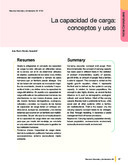| dc.contributor.author | Morales Aymerich, Jean Pierre | |
| dc.date.accessioned | 2015-03-19T21:44:20Z | |
| dc.date.available | 2015-03-19T21:44:20Z | |
| dc.date.issued | 2011-08 | |
| dc.identifier.issn | e-ISSN: 1659-1216 | es_EN |
| dc.identifier.uri | https://repositorio.catie.ac.cr/handle/11554/6445 | |
| dc.description.abstract | Desde la antigüedad, el concepto de capacidad de carga ha sido utilizado en diferentes ramas de la ciencia con el fin de determinar atributos de objetos, cualidades de los seres vivos, límites intrínsecos del crecimiento o número de seres humanos que un territorio puede albergar. Una de las bases del concepto es la ecuación logística de crecimiento, donde la constante K representa el límite y se define como la capacidad de carga del sistema. En cuanto a la capacidad de carga enfocada en las poblaciones humanas, las orientaciones no son menos diversas, pues en ella inciden factores demográficos, ecológicos, culturales y sociales. La mayoría de las teorías de capacidad de carga tienen un enfoque unidireccional, aunque las sociedades y los demás sistemas que ocurren en un territorio son multidireccionales. Es por ello que la conceptualización de la capacidad de carga debe ser más amplia para que, por medio del modelaje, se convierta en una adecuada herramienta para la gestión de las realidades humanas. | es_ES |
| dc.description.abstract | From time immemorial, the concept of carrying capacity has been used in different fields in the definition of product characteristics, quality of species, growth limits, or amount of people that a territory is able to support. This concept is rooted on the logistic growth equation, where K represents the limit and is defined as the system’s carrying capacity. In relation to human populations, the concept is also highly diverse, as several factors influence on it, such as demographic, ecological, cultural, and social factors. Most of the carrying capacity theories hold a unidirectional focus, while social and all other systems within a territory are ultidirectional. That is the reason why the carrying capacity concept needs to be enlarged, so that, through modeling, it becomes a useful management tool of human provisions. | en_EN |
| dc.publisher | CATIE, Turrialba (Costa Rica) | |
| dc.relation.ispartof | Recursos Naturales y Ambiente Número 63 (Agosto 2011), páginas 47-53 | |
| dc.rights | nfo:eu-repo/semantics/openAccess | |
| dc.subject | ENTORNO SOCIOECONOMICO | |
| dc.subject | CAPACIDAD DE CARGA | es_ES |
| dc.subject | DENSIDAD DE LA POBLACION | es_ES |
| dc.subject | SUPERPOBLACION | es_ES |
| dc.subject | DISPONIBILIDAD DE ALIMENTOS | es_ES |
| dc.subject | IMPACTO AMBIENTAL | es_ES |
| dc.subject | DEGRADACION AMBIENTAL | es_ES |
| dc.title | La capacidad de carga: conceptos y usos | es_ES |
| dc.type | Artículo | es_ES |


